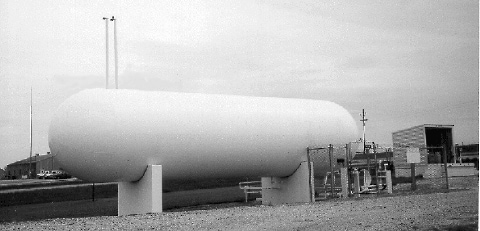Hazard ID 7 – Fire Fighting Hazards During Propane Tank Fires
June 1999
DHHS (NIOSH) Publication Number 99-129

Description of Hazard
On April 15, 1998, the National Institute for Occupational Safety and Health (NIOSH) investigated the line-of-duty deaths of two volunteer firefighters (Report No. 98F14). The investigation was part of the NIOSH Fire Fighter Fatality Investigation and Prevention Program. Both firefighters were part of a volunteer fire department that responded to an 18,000-gallon bulk propane tank fire.
The fire started after unprotected external piping from the tank was struck by an all-terrain vehicle and the propane vapors were ignited by a pilot flame from a nearby vaporizer. Upon arrival at the fire scene, the firefighters watered down the buildings adjacent to the propane tank and allowed the tank to burn itself out, since the tank was venting. About 8 minutes after the fire fighters arrived, the tank exploded, separated into four parts, and flew in four directions. The two firefighters (who were approximately 105 feet from the tank) were struck by a piece of the exploding tank and killed instantly. Six other firefighters and a deputy sheriff were injured as a result of the explosion. Such explosions may occur whenever flames contact propane tanks.

An 18,000-gallon propane tank with protective fencing to reduce the risk of physical damage to the exterior piping system.
Recommendations for Prevention
During propane tank fires, the potential always exists for an explosion known as boiling liquid expanding vapor explosion (BLEVE). To reduce this risk, fire departments, fire fighters, and propane tank owners and users should follow the recommendations below. They are based on emergency response procedures in the 1996 North American Emergency Response Guidebook (NAERG96), which were developed jointly by Transport Canada, the U.S. Department of Transportation, and the Secretariat of Communications and Transportation of Mexico.
Fire fighters should do the following:
- Fight fire from the maximum distance possible, or use unmanned hose holders or monitor nozzles.
- Cool containers by flooding them with large quantities of water until well after fire is out.
- Do not direct water at the source of leak or at safety devices; icing may occur.
- Leave the area immediately if you hear a rising sound from venting safety devices or see discoloration of the tank.
- For massive fires, use unmanned hose holders or monitor nozzles; if this is impossible, leave the area and let the fire burn.
- Be aware that when a BLEVE occurs, sections of the tank can fly in any direction. Just avoiding the ends of the tank should not be considered a safe operating procedure.
Fire departments should do the following:
- Follow the OSHA regulations [29 CFR*1910.120 (q)]Emergency response to hazardous substance releases]. These regulations should be incorporated into fire department standard operating procedures (SOPs), which should be strictly enforced.
- Train first responders to be aware of the hazards associated with propane tank fires, including BLEVE.*CFR = Code of Federal Regulations
- Ensure that fire department code enforcement personnel adhere to the guidelines specified by the National Fire Protection Association (NFPA) and NAERG96 for the evaluation and certification of propane tanks.
- For more information about safe fire fighting procedures for propane tank fires, see NAERG96 or contact the NFPA, the National Propane Gas Association (NPGA), or the International Fire Service Training Association (IFSTA).
Propane tank owners and users should do the following:
- Protect above ground external piping from physical damage with fencing or other protection Equip propane tank piping with excess-flow valves and emergency shutoff valves in accordance with the NFPA 58, LP-Gas Code.
The Fire Fighter Fatality Investigation and Prevention Program is conducted by NIOSH. The purpose of the program is to determine factors that cause or contribute to fire fighter deaths suffered in the line of duty and to develop strategies for preventing similar incidents in the future.
Acknowledgments
The principal contributors to this publication were Richard W. Braddee and Frank C. Washenitz II. Jerome P. Flesch provided technical review, and Kristina Wasmund and Vanessa Becks provided desktop publishing.
Hazard ID 7 – Fire Fighting Hazards During Propane Tank Fires [PDF – 96 KB]
